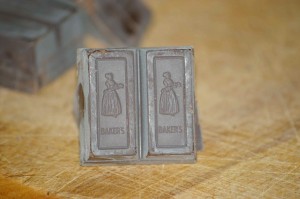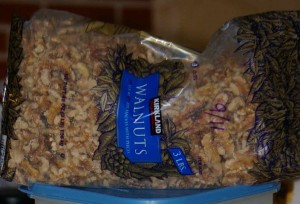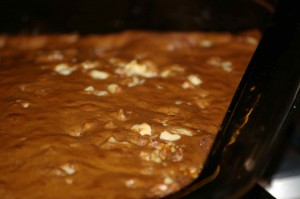What is the secret to fudgy brownies? From scratch?
by late night guest blogger Chef Betharoni
This, my dear readers, is where the secret lies:
And this is the secret, kept by my mother since 1978, when, as a penniless student, she managed to stretch her pockets enough to purchase the small reunion cookbook.
When we lack unsweetened chocolate squares, we follow the penciled in substitutions using cocoa powder and butter. No matter the ingredients on hand, the results have always been fully deserving of the capitalized and exclamationed “Good!” written in the left-hand margin.
Brownies are an inherently simple baked good; tamper with them too much and you end up with not-brownies. Less flour and you have fudge, more flour, you have cake, more egg gets souffle-y and less sugar makes it more of a biscuit.
 The ingredients look like they belong together, which I take to be a good sign.
The ingredients look like they belong together, which I take to be a good sign.
The saddest part of the secret is that a good fudgy brownie, made from scratch, will require fat, calories, and a leetle more fat.
The happiest part of the secret is that this fat comes via chocolate and butter, which are good friends of any pastry chef.
Just as the three rules for real estate are location, location and location, the three rules of French cooking are frequently listed as butter, butter, and butter.
This guideline is based on two facts regarding fats, particularly natural fats such as butter. Fat carries flavor and fat tenderizes. Too much butter in a cake batter and it ends up structure-less. Work your butter into your pie crust properly and you end up with a tender and flavorful crust.
While giving butter full credit, it would be a mistake to not spend some time on the sugar and eggs. When I was still taking my culinary classes, one of my assigned bakery lab experiments was to increase and decrease the amounts of sugar in a cupcake recipe and observe the results. The cakes with less sugar lacked flavor and structure, while the ones with an excess … exploded in the oven. Sugar as an explosive – who knew?  Whisking the eggs with the sugar until the mixture is thick and fluffy provides some air and structure for the brownies, while the correct ratios, plus beating yolks and whites together, prevent an overly fragile and airy dessert.
Whisking the eggs with the sugar until the mixture is thick and fluffy provides some air and structure for the brownies, while the correct ratios, plus beating yolks and whites together, prevent an overly fragile and airy dessert.
Adding the warm chocolate and butter to the mixture deflates it somewhat, but the incorporated air helps avoid accidentally cooking the yolks with overly warm chocolate. When melting the chocolate, it is helpful to melt it with the butter, this prevents burning of the chocolate and makes a smoother mixture to add to the eggs and sugar.


In return for all the butter, sugar, and eggs you have added to your batter, you may avoid unnecessary carbohydrates as you proceed to add the flour and salt. It takes very little flour to counter the moisture of the eggs enough to reach the proper level of moist, yet slightly firm, chocolate that fudgy brownie eaters desire.
Here, the printed recipe suggests the addition of nuts, which we sometimes add. We have also been known to add m&ms, chocolate chips, and oatmeal, in various combinations. Much like a choose-your-own ice cream shop, the mix-ins here are up to your discretion, although it is wise to keep in mind that additions such as oatmeal will make the final product slightly drier, unless you compensate with extra liquid or less flour. 
Once the mix-ins have been folded in, the batter can be slipped into a pan, which can be slipped into an oven, where it can sit for approximately half-an-hour, while you clean the kitchen.
 I won’t judge you if you decide that the best way to clean the mixing bowl requires that you consume some of the batter.
I won’t judge you if you decide that the best way to clean the mixing bowl requires that you consume some of the batter.
Now, if you have kept your ratios and mixing methods in order so far, there is one final secret to the fudgy brownies. You have to remove the pan from the oven while they are still moist and soft in the center. The top will gloss over beautifully and form a crisp top layer, but underneath, you want there to be lurking beneath the surface a layer of still malleable chocolate, not yet formed into a firm structure, with only semi-distinct crumbs to give a hint of previously applied heat.
And I imagine everyone already knows the next step.






